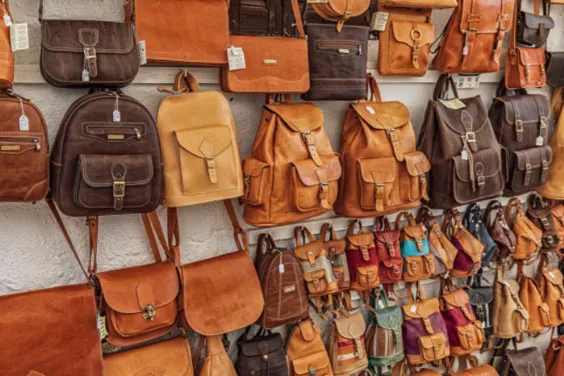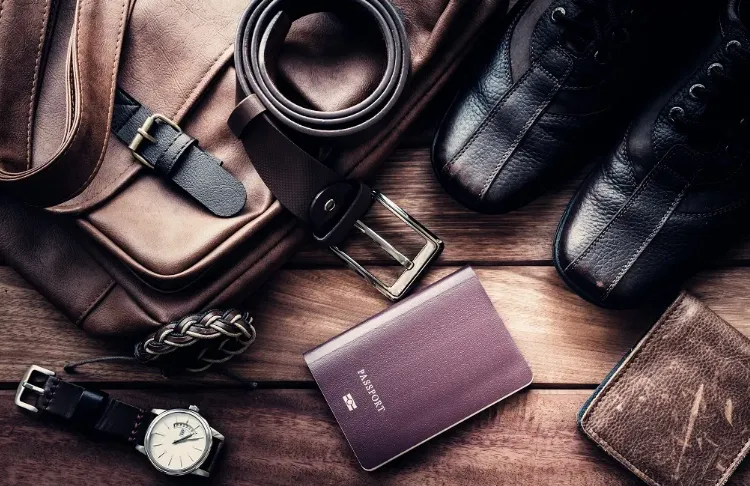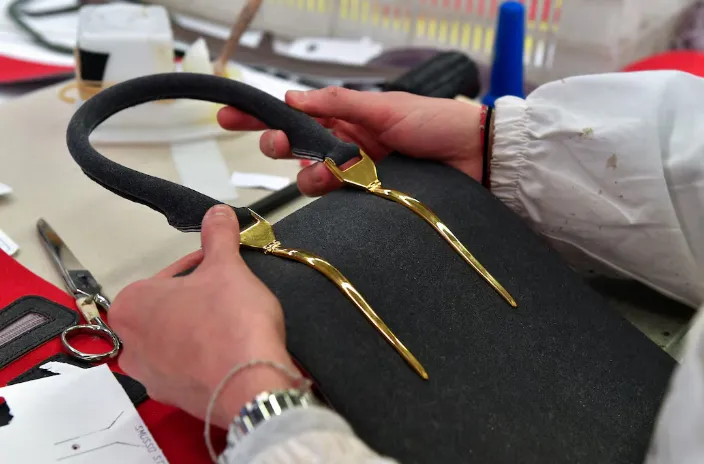How to Source Leather from China: An Importer's Guide

For brands and businesses worldwide, sourcing leather from China isn’t just an option—it’s a strategic necessity. The country offers an unparalleled ecosystem of manufacturing prowess, cost efficiency, and scalability. But for the uninitiated, the process is a minefield of potential missteps that can cost thousands.
This guide cuts through the noise. We provide a clear, five-step framework developed from years of on-the-ground experience, not just theoretical advice. You'll learn how to find reliable partners, ensure impeccable quality, navigate complex logistics, and ultimately, build a profitable and resilient supply chain.

Let's be clear: China's dominance isn't accidental. It's the result of decades of strategic development.
The Manufacturing Juggernaut: Over 70% of the world's leather goods pass through China. Cities like Guangzhou, Dongguan, and Wenzhou are not just cities; they are specialized leather ecosystems. This concentration means access to every component, from premium hides to specialized zippers, all within a few hours' drive.
The Real Cost Advantage: It's not just about labor. It's about integrated supply chains. A tannery, a hardware factory, and an assembly plant often operate in symbiotic clusters. This efficiency translates to real savings. On average, leather bags sourced from China cost 40-60% less than those manufactured in Europe or the US, allowing for competitive retail pricing or healthier margins.
Skill & Scalability: The workforce is highly skilled. Craftsmen with decades of experience work alongside state-of-the-art cutting machines. This blend of artisanal skill and modern technology allows a factory to produce a small batch of 100 bespoke handbags one month and scale up to fulfill an order of 10,000+ units the next.
The challenge? Navigating this vast landscape requires a map. And that's what this guide is.
Ambiguity is your biggest enemy. Vague requests lead to miscommunication, endless sample revisions, and products that miss the mark. Before you even lookfor a supplier, you must have an internal technical pack ("tech pack").
"Genuine leather" is a broad term. You must specify exactly what you need.
Full-Grain Leather: The highest quality. It includes the entire grain layer, is incredibly durable, and develops a patina over time. Cost: 25–45/ft². Ideal for luxury bags.
Top-Grain Leather: Sanded and refinished to remove imperfections. Softer and more pliable than full-grain but less durable. Cost: 15–30/ft². A great balance for mid-range products.
Vegetable-Tanned Leather: Tanned using natural organic materials (tree bark, etc.). Eco-friendly, biodegradable, and develops a rich color over time. Cost: 12–20/ft². Key for brands marketing sustainability.
Vegan Leather (PU/PVC): Not a single material. Can be made from PU, PVC, or innovative bio-materials (apple, cactus). Specify the type. Cost: 5–12/ft².
Pro Tip: Always request physical leather samples (swatches) from your potential suppliers. Screen colors lie.

Your tech pack is your bible. It must include:
Detailed CAD Drawings: With every dimension (LxWxH) in both metric and imperial.
Pantone (PMS) Codes: For every color element—the exterior leather, interior lining, stitching thread. Do not use descriptions like "sky blue."
Hardware Specs: Specify zipper brands (YKK is industry standard), buckle types, and finish (e.g., antique brass, polished nickel). Provide samples if possible.
Interior Layout: How many pockets? Zippered? Open? Phone sleeve? Laptop compartment? Diagram it.
Branding Details: Exact logo placement, size, and production method (embossing, debossing, metal logo).
Without this, you're asking for trouble.
Forget endlessly scrolling Alibaba. A professional approach saves time and mitigates risk.
B2B Platforms (Alibaba, Made-in-China): Useful for initial research. Use filters to find "Gold Suppliers" or those with "Assessed" verification. Warning: These platforms are filled with trading companies, not factories. Always verify.
Trade Shows: The Canton Fair (Guangzhou) is the most famous. This is your best chance to meet factories face-to-face, assess quality firsthand, and build relationships. The travel investment is often worth it.
Sourcing Agents: The ultimate shortcut for newcomers. A good agent based in China has existing factory relationships, speaks the language, and understands cultural nuances. They handle factory audits, negotiations, and QC. Their true value is often in risk mitigation. For instance, one of our clients avoided a $20,000 loss on a miscommunicated leather color because our agent's mandatory pre-production confirmation process caught the error. Their fee (typically 5-10%) is often saved by avoiding one costly mistake.
When you find a potential supplier, demand this information:
Business License: Verify it's legitimate.
Factory Audit Reports: Do they have BSCI, ISO 9001, or SMETA certifications? These indicate a commitment to ethical and quality processes.
Client Portfolio: Have they worked with Western brands? Ask for examples.
Communication: Is their response professional, timely, and in clear English? A slow, confusing response now indicates bigger problems later.
Sample Policy: Will they provide a prototype sample? What are the costs? (Note: Paying for a sample is standard and a sign of a serious factory).
Red Flags: Avoid suppliers who are unwilling to provide this information, offer prices that seem too good to be true, or pressure you for full payment upfront.
Sampling is your quality checkpoint beforeyou invest thousands in mass production. Do not rush it.

Prototype Sample: The first sample made based on your tech pack. Expect imperfections. This sample is for checking overall design, dimensions, and functionality.
Pre-Production Sample (PPS): Made with the exact materials and components planned for mass production. This sample must be perfect. Your approval of the PPS greenlights mass production.
Production Sample (PS): A random sample taken from the first production batch to verify mass production quality matches the approved PPS.
Material: Check the feel, smell, and grain of the leather. Compare it to your approved swatch.
Stitching: Look for consistent stitch length (8-10 stitches per inch is standard), tight thread tension, and no loose threads. Pay extra attention to stress points like handles and straps.
Hardware: Test zippers and clasps repeatedly. They should open and close smoothly. Check for scratches or uneven plating.
Structure: Fill the bag. Does it hold its shape? Do the straps align correctly?
Measurement: Measure the sample. Does it match the dimensions in your tech pack? (A 1-2mm tolerance is acceptable).
Reject any sample that doesn't meet your standards and provide the factory with detailed, photographic feedback.
This is where your freight forwarder earns their keep. Getting your product made is only half the battle; getting it to your warehouse efficiently and legally is the other.
|
Method |
Cost (Approx.) |
Transit Time |
Best For |
|---|---|---|---|
|
Express Air (DHL/UPS/FedEx) |
High (7−12/kg) |
3-7 days |
Urgent samples, very small, high-value orders |
|
Air Freight (Air Waybill) |
Medium-High |
5-10 days |
Mid-sized orders, faster stock replenishment |
|
Sea Freight (FCL/LCL) |
Low (3.5−7.0+/kg, varies widely) |
30-45 days |
Large orders, non-urgent inventory, best cost efficiency |
FCL (Full Container Load): You rent an entire 20ft or 40ft container. More secure and faster port clearance.
LCL (Less than Container Load): You share container space with other shipments. Cost-effective for smaller orders but slower due to consolidation. Note: The per-kg cost for LCL is highly sensitive to fuel surcharges and market congestion.
Your total cost is NOT just the product cost. It's the Landed Cost:
Landed Cost = (Product Cost) + (International Freight + Insurance) + (Export/Import Customs Fees) + (Tariffs, VAT, Taxes) + (Domestic Trucking)
Failure to calculate this will destroy your profit margins. For example, a 20% VAT on your product's declared value can be a significant unexpected cost.
Your freight forwarder will help, but you must provide accurate data for:
Commercial Invoice: Declares the value of your goods for customs.
Packing List: Details every item in every carton, including dimensions and weight.
Bill of Lading (B/L): The title of the goods.
Certificate of Origin (COO): Often required to prove where goods were manufactured, which can affect import duties.
You cannot assume the entire production run will match your approved sample. Quality control is a proactive process.
During Production (DUPRO): Have an inspector visit the factory during production to catch issues early—e.g., checking leather cutting or stitching before 1000 units are completed wrong.
Pre-Shipment Inspection (PSI): This is the most critical inspection. Once 80% of the order is packed, an inspector randomly selects cartons based on the AQL (Acceptable Quality Level) standard:
AQL 2.5 (Industry Standard): Allows a small percentage of minor defects.
AQL 1.5 (Stricter): For higher-quality goods.
AQL 0.65 (Near-Perfect): Used for luxury products where even a minor flaw is unacceptable.
Workmanship & Functionality: Seams, zippers, straps, alignment.
Dimensions: Conformity to specifications.
Quantity & Packaging: Correct quantities, proper labeling, and damage-free shipping cartons.
Investing a few hundred dollars in a professional pre-shipment inspection can save you from accepting thousands worth of defective goods.
Sourcing leather from China is a detailed process of preparation, relationship building, and diligent oversight. It demands respect for the complexity of international trade.
By following this five-step framework, you move from being a passive buyer to an informed partner. You gain control over quality, costs, and timelines. You build a supply chain that becomes a core, competitive asset for your business.
Q1: What's the biggest hidden cost when shipping leather goods by sea that beginners forget?
A: Beyond the freight charge itself, beginners often underestimate Destination Charges. These are fees applied by the port and logistics companies at the arrival port for handling, administration, and equipment usage. They are separate from customs duties and can add several hundred dollars to your total cost. Always ask your freight forwarder for an estimate of these D&D (Destination and Delivery) charges upfront.
Q2: Can I legally import "genuine leather" samples without paying full duties?
A: Yes, most countries have allowances for low-value commercial samples. You can often ship samples marked clearly as "COMMERCIAL SAMPLE - NO VALUE" or with a declared value under a specific threshold (e.g., $800 USD for the US) to be exempt from duties. However, the shipment must truly be a sample and not a disguised commercial batch.
Q3: My supplier offers "DDP" shipping. What does that mean and is it a good idea?
A: DDP (Delivered Duty Paid) means your supplier (or their forwarder) handles everything, including paying the import duties and taxes in your country. While it seems convenient, it often comes at a premium and you lose visibility and control over the final leg of shipping. For beginners, it can be a good way to start, but as you scale, FOB (Free On Board) is usually more cost-effective and transparent, as you control your own logistics.
Q4: How do I handle a situation where my goods are held by customs in my country?
A: First, don't panic. Contact your freight forwarder immediately. They will liaise with customs brokers to find out the reason. Common hold-ups include incomplete paperwork, an unclear product description, or a request for more information to determine the correct duty classification. Having a reliable forwarder is crucial here, as they are your expert on the ground to resolve these issues.
Q5: Is it necessary to get cargo insurance even for sea freight, which is considered safe?
A: Absolutely. While sea freight is statistically safe, incidents do happen: containers can be lost overboard, damaged in storms, or affected by fire or water from other cargo. Cargo insurance is a small percentage of the total shipment value (often 0.3-0.5%) and provides critical protection against total loss or significant damage that would otherwise be a devastating financial blow.
Q6: What is a "forwarder's certificate of receipt" and do I need it?
A: An FCR is a document issued by a freight forwarder acknowledging they have received the goods for shipment. It is not a title document like a Bill of Lading. It's useful for payment terms; you can show the FCR to your bank as proof of shipment if your Letter of Credit requires it. It streamlines the process but doesn't give you the same control over the goods as a Bill of Lading.
Q7: My leather goods have a strong smell upon arrival. Is this normal?
A: A slight "new leather" smell is normal, but a strong, chemical odor is a red flag. It could indicate poor tanning processes or the use of substandard adhesives and coatings. This is a quality issue. Air the products out thoroughly. For future orders, specify your expectations for low VOC (Volatile Organic Compound) materials and consider a third-party test if the smell is overwhelming.
Q8: Can a supplier steal my design if I send them a detailed tech pack?
A: The risk exists, but it can be mitigated. Before sharing sensitive designs, have the supplier sign a Non-Disclosure Agreement (NDA). Reputable factories value their long-term business relationships more than stealing a single design. However, for highly innovative designs, consider working with a sourcing agent who can vet the factory's reputation beforehand or splitting the development process between different suppliers.
Q9: What is the minimum viable order (MVO) I can start with to test a supplier?
A: While many factories have high MOQs, you can often negotiate a pilot order or MVP (Minimum Viable Product) order. This is a small, paid order (e.g., 50-100 units) specifically to test the supplier's quality, communication, and reliability before committing to a full production run. Frame it as a test for a larger, ongoing partnership, and be willing to pay a slightly higher per-unit cost for this trial.
Contact us
Call Us: +86 193 7668 8822
Email:[email protected]
Add: Building B, No.2, He Er Er Road, Dawangshan Community, Shajing Street, Bao'an District, Shenzhen, China